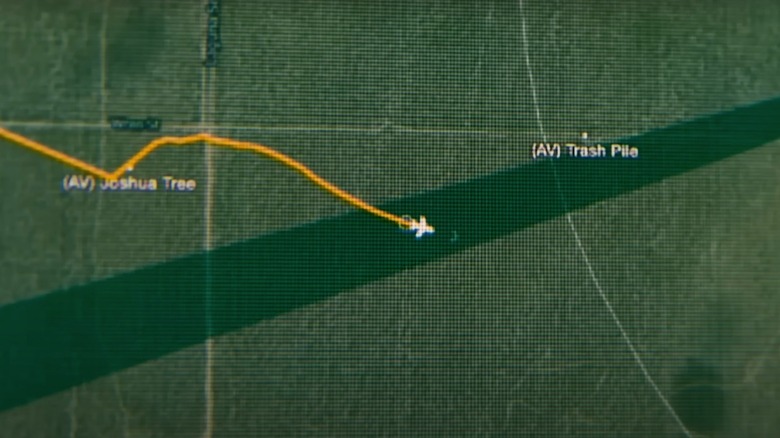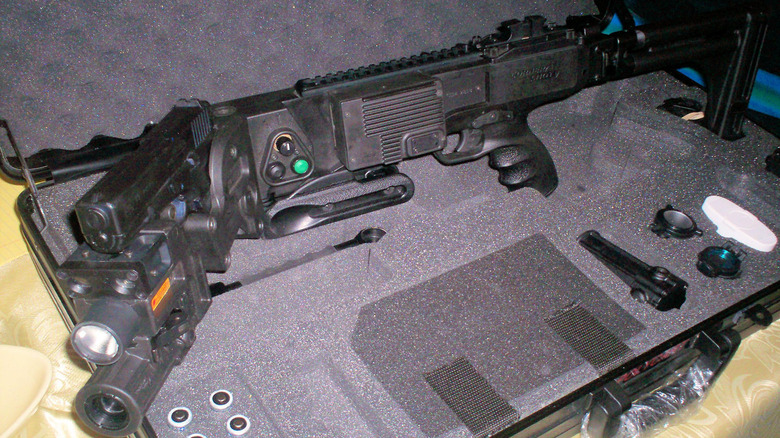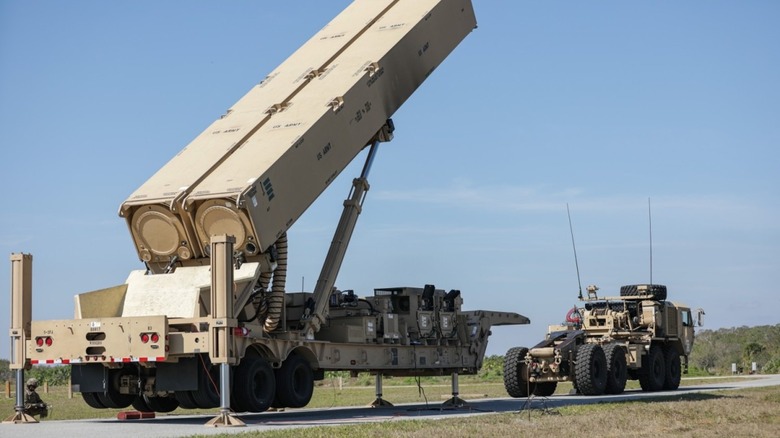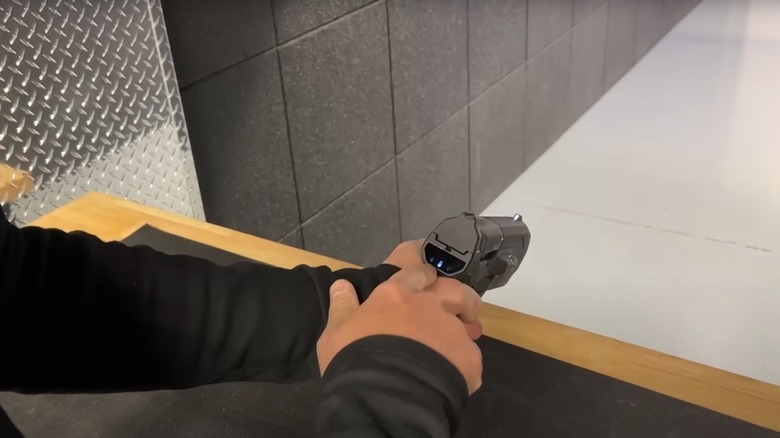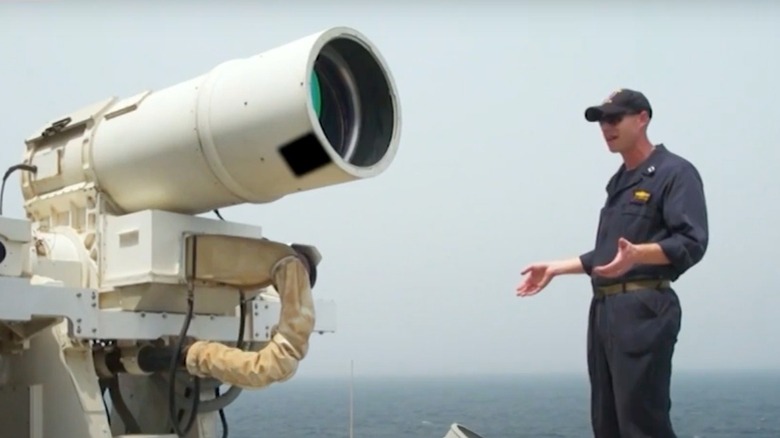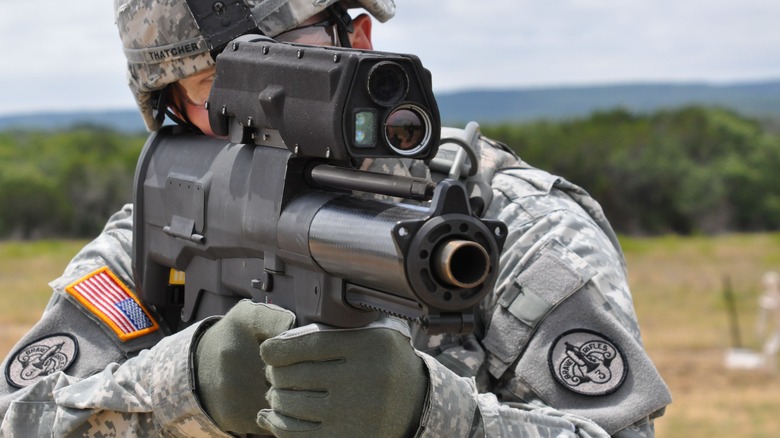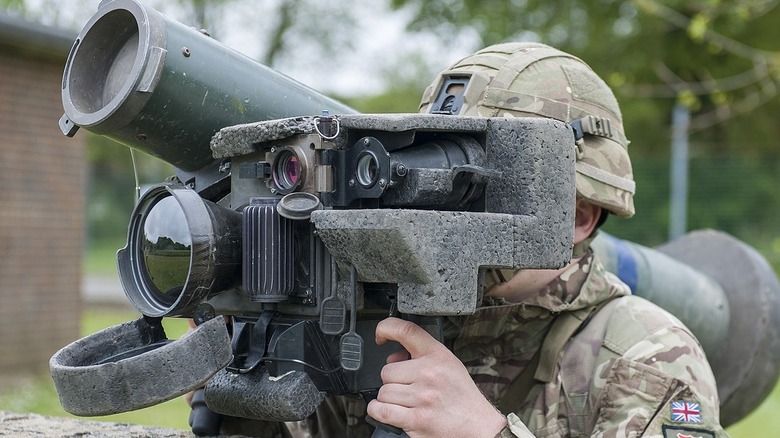12 Unbelievable High-Tech Military Weapons That Actually Existed
Science fiction may seem like a genre of speculation, where its fanciful gadgets break the laws of physics with no concern for actual feasibility. Sometimes, though, it's a template. Technology that we now take for granted often began in the imagination of sci-fi writers. Halfway through the 20th century, novelists began writing "hard" sci-fi, adhering rigidly to the laws of physics. Powered exosuits in "The Forever War" by Joe Haldeman are now in active development by the military; the impeller drives of the Honor Harrington universe (effectively force fields) have seen a partial fulfillment in DARPA's Iron Curtain protection system. So what about all the weapons? Do we finally have rods from God, orbital laser cannons, and sonic shotguns?
Well, sort of. Whether inspired from sci-fi or crafted by clever engineers, there are weapons that exist (or have existed) that wouldn't be out of place in an "Expanse" novel. Some saw active military or law enforcement service, some are still in development, and some never made it past the prototype phase — but all of them did at least work. Here are 12 of them.
Anduril Lattice OS — The beginning of AI warfare
"Terminator" stoked our fears of automated, malevolent machines that are smarter than humans. And with how ChatGPT and company are shaking up the world right now, it only seems logical that AI will enter the trenches someday. Military UAVs (unmanned aerial vehicles, or drones) like the infamous Predator have been around for decades, but they require a team of operators to pilot them and make the big decisions. Drones are becoming an ever bigger part of modern warfare as evidenced by the war in Ukraine. With the help of Anduril's Lattice OS, we may soon see a terrifying, "Terminator"-esque reality where these unmanned aircraft do war all on their own.
Lattice OS is the "operating system" of war. It enables one person to become the puppet master of a swarm of autonomous drones. On YouTube, Wendover Productions explains how a network of sensors and drones can identify a threat (like an enemy drone) and eliminate it. The operator on duty only exists to authorize the attack.
Now, Lattice OS and its accompanying military hardware have not been deployed on the fields of battle. The technology is currently seeing active use along the U.S. border to detect unauthorized crossings, according to The Guardian. However, the subtext is clear: We're on a collision course with a future where AI pulls the trigger, not humans.
DARPA EXACTO — Self-steering bullets
Smart bullets that lock onto a target and follow it are a staple of sci-fi. You don't have to aim — you just pull the trigger and the gun does the rest. DARPA's EXACTO (Extreme Accuracy Tasked Ordnance) aims to make that concept a reality. According to the agency, the EXACTO allows anyone — an experienced sniper or a complete novice — to hit a target at great distance, day or night. It uses a custom-made .50-caliber self-steering projectile that compensates for weather elements and the target's movement. A video released by DARPA in 2015 (above) demonstrates the tech in action on a moving target — the bullet changes its flightpath in real time before striking the objective.
No one knows how the self-steering technology works. It's very likely confidential information considering how big of an edge such an innovation would give the military — which the Russian Federation doubtless realized considering it kicked off development of its own version. There has also been no news about the program since 2015. It's unclear if it was canceled, or if it just needs more time in the oven. In any case, the tech works, and it could potentially reshape warfare entirely once perfected for infantry.
Active Denial System — A non-lethal crowd control device
Heat rays go back to H.G. Wells' "The War of the Worlds," and the Active Denial System follows in those footsteps. It isn't a lethal weapon, and it doesn't produce a visible ray of light, but it's no less terrifying. Dubbed the "voice of God," the ADS causes its targets to feel like their skin is burning, inducing a primal urge to flee and vacate the area — hence the "denial" (as in "area denial") part of the name.
According to the U.S. Department of Defense's Joint Intermediate Force Capabilities Office, the ADS directs millimeter wave energy beams that penetrate 1/64th of an inch into the skin and excites water and fat molecules, producing a painful heating sensation. Though nonlethal, it could theoretically cause harm if pointed at someone for too long. However, the pain is too intolerable for a person to willfully withstand, and operators are trained not to keep it on targets for long, anyway.
You can see the system in action above. A group of mock protesters scatter like they've been smitten by this "voice of God" without suffering any injuries. Naturally, such a system is intended as a nonlethal crowd control weapon, particularly for the purposes of the military — they can clear hostiles out of an area without firing a shot. The ADS is a close cousin of the long-range acoustic device (LRAD) system (which disperses crowds with loud noise), although the latter causes serious hearing damage. However, the ADS may have been overhyped, since it never saw combat in Afghanistan due to its ineffectiveness with thick clothing and wet weather.
Taser XREP — A Taser in a shotgun
The Taser goes back longer than you think. Development began in the '70s, with police forces taking interest in the device in the '90s to mitigate their controversial use of deadly force. Nowadays it's an officer's best friend for de-escalating violent encounters, but it has two major limitations. One, the effective range maxes out at 25 feet, with the exception of the newer TASER 10 that can go up to 45 feet. Two, reloading a Taser isn't quite so easy, especially in high-adrenaline situations with sweaty, shaking hands and more than one violent person threatening the user's life. So, officers have to get uncomfortably close to a threat, and they've got only one shot. The XREP Taser solves both of those problems.
Instead of a dedicated handgun, the XREP (eXtended Range Electronic Projectile) is a self-contained Taser round that can be used with any 12-gauge shotgun. There's quite a complicated multi-stage process that makes it work: After firing, the battery switches on, fins deploy to stabilize the heavy round for accuracy, then the electrode barbs stick in the target's skin and cause the same NMI (neuromuscular incapacitation) as a standard Taser. According to Wired, the effective range of an XREP shell (different from standard shotgun slugs or pellets) is 100 feet, and reloading one is fairly easy.
CornerShot — A gun that shoots around corners
There's no way for a soldier or law enforcement officer to peek out from behind cover without exposing some part of their body. The CornerShot rifle platform aims to solve that problem by letting its user aim around the corner while staying safe. It comes in two halves: a pistol mount and camera attached by a 60-degree hinge at the front, with a stock, monitor screen, and grip at the back. So when operators want to check around a corner, they swivel the hinge and use the camera-monitor system to safely scan the area for threats — and engage if necessary.
It was a cool idea with the potential to save the lives of soldiers and law enforcement, at least in theory. But according to Sandboxx, it never caught on in the U.S. for a couple of reasons. One, it's the size of a rifle without any actual rifle advantages — pistols aren't known for their long range, magnified optics, and body armor penetration. Two, the camera screen wasn't all that easy of a targeting device to use, and the battery only lasted 160 minutes. Three, CornerShot excels only in a very niche use case: looking and shooting around corners. The military has had effective tactics for safely getting (or shooting) around corners for some time, making an entire platform devoted to that cause a bit excessive.
[Featured image by Andrew Levine via Wikimedia Commons | Cropped and scaled]
Railgun — An electromagnetic propulsion cannon
The railguns is to sci-fi what the sword is to fantasy. The name evokes a super advanced weapon that's hundreds of years ahead of current human technology. Except in actuality, it's not. You can make a rail gun at home. All it is is two parallel electromagnets (the rails in "railgun") that accelerate metallic projectiles via its magnetic fields. In military applications, it could launch them at speeds faster than gunpowder can. Railguns would theoretically be safer to operate, have ranges of up to 100 miles, and their raw kinetic force (think Mach 7.4) would hit so hard they wouldn't even need an explosive payload. The U.S. military believed a functional railgun would put their warships in a class of their own and has been dumping a ton of money into the project since 2005.
So why aren't railguns part and parcel of a modern warship? The answer comes down to two things: energy requirements and heat. To create a magnetic field capable of launching a projectile at Mach speeds, you need millions of amps of energy — so much you'd probably need an sci-fi power source to fuel it. As you can guess, it's not practical when other solutions have far more limited requirements.
Second, the resistive heat really tears up the rails. This isn't like a World War I machine gun where you can simply swap out the barrel once it overheats — this is a gun installation on a ship that ought to fire more or less indefinitely. Alas, the Navy mothballed the project in 2021. Still, this prototype weapon did work, and you can see it firing in videos like the one above.
[Featured image by U.S. Navy via Wikimedia Commons | Cropped and scaled]
The KRISS Vector — A recoil-free rifle
Weapon recoil seems like an inevitable consequence of Newtonian physics — for the bullets to go out the barrel with any meaningful velocity, the gun has to kick. Therefore, weapons that fire on full-auto are necessarily going to forfeit a ton of accuracy. Not with the KRISS Vector. It has a highly unique action that transitions blowback down onto a slider mass rather than backward as most weapon platforms do, thus canceling out most of the perceived recoil. That's why the Vector has such a curious, overlarge lower receiver — it needs space for the bolt to hinge down and create a counterbalancing mass.
The result? The operator can shoot rounds downrange very fast (1,200 per minute fast) with very minimal barrel climb. Garand Thumb gives the Vector a live-fire demonstration on YouTube (above), and you can see for yourself how the barrel stays almost flat even as he dumps a whole magazine.
The downsides of the weapon are twofold: One, it uses small-caliber .22LR ammo rather than rifle cartridges because of how large the counterbalance system is. Two, it's more costly to produce and maintain than a weapon with a standard action. Unlike most of the items on this list, however, the Vector has seen active use, but only in Thailand, Bangladesh, and Panama. It's also available for civilian purchase in America. While the Vector didn't change the recoil paradigm, it did create a fascinating weapon platform that won't be forgotten.
Hypersonic missiles
Throughout the Cold War, the United States' collective nightmare was the Soviet Union launching an ICBM (intercontinental ballistic missile) and wiping out the Eastern American seaboard in one fell swoop — leaving only enough time to counterstrike with our own. Those fears may finally be over after the U.S. military successfully shot an ICBM down in 2020 during a test in Hawaii. However, the hypersonic missile, if made a reality, could create a new era of terror. Unlike ICBMs, which use a parabolic rocket launch and then fall back into the atmosphere, hypersonic missiles use scramjets (reaching up to Mach 5) to glide at low altitudes in the atmosphere.
Hypersonic missiles would have two theoretical benefits over ICBMs: They're only detected by enemy radar when it's too late, and they can evade being intercepted by enemy countermeasures. So rather than having a couple of minutes of warning to duck and cover after the launch of an ICBM, you'd have much less — and the military would most likely not be able to shoot it down. Most major superpowers have been testing hypersonic missiles, which gives the worrying impression we're about to enter a new age of nuclear warfare.
However, that's all theoretical. In the realm of reality, hypersonic missiles come with a host of glaring disadvantages. They suffer immense atmospheric drag (negating the whole hypersonic aspect), are prone to overheating, and have an initial launch phase that makes them quite detectable — so, not stealthy. We may see short-range hypersonic missiles on the battlefield, but not the long-range, world-ending capacity.
[Featured image by U.S. Army via Wikimedia Commons | Cropped and scaled]
The Biofire Smart Gun — A biometrically unlocked weapon
Guns that only fire for a specific user (such as by reading their palm print) are another sci-fi signpost, and Biofire has made them a reality. The Biofire Smart Gun becomes fireable only once the user biometrically unlocks it with their face or fingerprint. Otherwise, it's a paperweight. The platform is marketed toward home defense, allowing owners to have a firearm at the ready (not in a gun safe, where it otherwise should be) that only they can access. Kids won't be able to hurt themselves if they play with it, nor could a home invader use it. It's available for purchase right now at $1,499, with orders shipping by 2025.
Forgotten Weapons tested the Biofire on YouTube and gave it fairly high praise for its security implementation and usability. The authentication is fast — so fast that it's ready to fire by the time it's been leveled and aimed. And if it can't read your face, the fingerprint makes for an excellent fallback. It's hard to say if the Biofire (or something like it) will reach the battlefield, but for now, we can tick off the box of "smart gun that only shoots for a registered user."
Drone-killing laser guns
As we've established, drone warfare (like that going on right now in Ukraine) is no longer science fiction, and there are plenty of ways to shoot down and disable enemy UAVs. There are net-launching drones, signal jammers, and even ramming aircraft. But one potential solution takes a page right out of the "Star Wars" book: laser guns.
Like the ADS, this is not a literal, visible laser beam that leaves a charred hole in its target. Instead, the light cooks the drone's circuitry and lets gravity do the rest. Railguns have prohibitively costly energy requirements, but the U.K. government said some drone lasers may cost all of $13 to fire a single time. Every major superpower out there is developing their own drone-killing lasers as the war in Ukraine makes clear this will be a part of contemporary battles.
It appears these laser guns are already in active deployment and use, too. According to Forbes, they may have already been shooting drones down since 2022. We may likely see future conflicts where laser drone killers become indispensable defensive countermeasures — perhaps even automated ones enabled by systems like Anduril's Lattice OS.
XM-25 HEAB — A smart, high-explosive airburst launcher
Mortar rounds are key to softening up enemy defenses, but they're "dumb" weapons. They rely on precise calculations by their operators, and once fired, it's up to God whether the round hits its target. That's where the XM-25 HEAB (high explosive airburst) launcher came in. Developed in 2011, it had a built-in computer and sensors so soldiers could choose a target up to 700 meters away and hit it precisely with 25mm ammo. They could even airburst the round (i.e., explode it right before impact) exactly where they wanted to. For a weapon created almost two decades ago, it still looks very sci-fi today.
For all its promise, the XM-25 never made an impact (pun intended). It was deployed in Afghanistan and even received the "Punisher" moniker by soldiers, but it was heavy, expensive, and exploded during a 2013 training event, wounding a soldier in the process. Not great. In addition to this, the XM-25 program was costly, there were countless delays, and an indirectly-related lawsuit hamstrung the contract. In 2018, the Army nuked the project and left it in the annals of history for good.
[Featured image by U.S. Army via Wikimedia Commons | Cropped and scaled]
The Javelin — The ultimate fire-and-forget tank missile
We've saved the best for last, and that is the FGM-148 Javelin. This is an anti-tank guided missile that a soldier can launch from their shoulder to eliminate a heavily-armored target without any manual guidance — a true fire-and-forget weapon. Development began way back in 1984, and the first successful human-fired test occurred in 1993. The Javelin saw active service as early as 1996.
The platform is all advantage and practically no disadvantage. It's relatively light, easy to use and reload, safe to operate near people and/or in buildings, boasts a 1.5-mile range, and "penetrates all known armor," according to a U.S. Marines handbook. Most importantly, the fire-and-forget aspect means soldiers can take their shot and then quickly flee to safety after revealing their position. The only disadvantage is that it costs about $80,000, and another $107,500 per missile.
The engineering under the hood is what really makes the Javelin seem sci-fi. On YouTube, Real Engineering describes however the missile algorithmically "learns" what its target looks like, then uses its nose-mounted camera and fins to home in. Before impact, its shaped charge (basically a molten metal spear) cuts through enemy armor. The Javelin has been used to great effect by dozens of countries — most recently Ukraine, which has a Saint Javelin.
[Featured image by Stuart A Hill AMS/MOD via Wikimedia Commons | Cropped and scaled]

